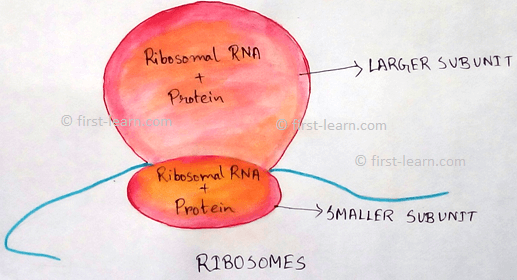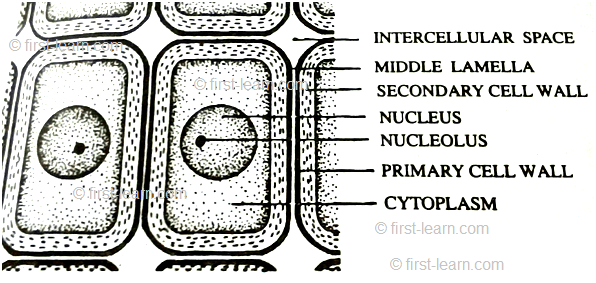Explain about Ribosomes
Definition - Ribosomes are small, granular, non- membranous structure which is mafe up of RNA and protein and concerned with protein synthesis.
In 1943 presence of ribosomes are first observed by Claude and later in 1955 Palade described a detailed description of it by define the name. Ribosomes are also named as Claude’s particles according to its discovery.
Distribution of Ribosomes - Ribosomes are all not equal in size. It is mainly found to remain attached with the endoplasmic reticulum of prokaryotic and eukaryotic cells. Some of the comparatively smaller ribosomes are present in the mitochondria and cytoplasm which are known as mitoribosome and cytoribosome.
In eukaryotic cells ribosomes are almost million in numbers whereas in bacterial cell contains almost 10,000 ribosomes. Number of ribosomes varies from cell to cell as it is more in those cells which are associated with protein synthesis. Ribosomes those are remain freely scattered in the cytoplasm are called monosomes. mRNA make cluster together to form polyribosome.
Origin of Ribosomes - It is found in all eukaryotic cells. These organelles are formed by the
joining of nucleolus and cytoplasm. The ribosomal RNA (rRNA) is formed in the
nucleus. In the eukaryotic cell they are remain attached to the endoplasmic
reticulum and are called rough endoplasmic reticulum.
In prokaryotic cell, the RNA is formed by the DNA thread which is present in the nucleoid region and the entire thing takes place in cytoplasm.
Structure of Ribosomes - these are spherical, oval, in shape, where two unequal subunits remain attached to each other by magnesium ions .It can be dissociated due to the decreased of magnesium ions. Among the two subunits bigger one is spherical and smaller one is oval. It does not contain any membrane as it is composed of special type of RNA, called rRNA (ribosomal RNA) and histone protein.
Chemical Composition of Ribosomes - It contains r-RNA and protein in equal amount in eukaryotic cells and in prokaryotic cell the ratio is 2:1.Ribosomes are remain attached with the rough endoplasmic reticulum by the compound called ribophorin.
Sedimentation co Efficient - As ribosomal subunits are of different sizes, these are particles can be identified by an index called sedimentation co efficient. It is the method which is done by ultracentrifugation methods. As the bigger one will be precipitate early and the smaller will be precipitate later. The rate of precipitation is expressed as the subunit called Svedberg unit. It is denoted as “ S”. Like 80S ,70S, 55S etc.
Different types of Ribosomes:
1. 80S ribosomes remain attached to the endoplasmic reticulum of eukaryotic cells. Two subunits are 60s + 40s.
2. 70S ribosomes freely scattered in the cytoplasm of prokaryote. Two subunits are 50s and 30s .
3. 55S ribosomes found in mitochondrial matrix. Two subunits are 35s + 25s.
Functions of Ribosomes:
Ribosomes have different functions-
1. Protein synthesis- Ribosomes are associated with protein synthesis.
2. m-RNA
formation- Ribosomes jointly formed the template on which the amino acids are
joined one after one to form the polypeptide chain of
protein.
From Explain about Ribosomes to HOME PAGE
Recent Articles
-
Explain about Growth in Plants |Definition of Growth & Differentiation
Feb 27, 25 02:07 PM
Growth is a permanent increase in length or volume of an organism that brought upon by an increase in its dimensions due to synthesis of new protoplasmic material. -
Definition of Respiratory Quotient | calculation | Application | Plant
Dec 02, 24 12:09 AM
Definition of respiration quotient- the ratio of the carbon-dioxide evolved to that of the oxygen consumed by a cell, tissue, plants or animals in a given time is called respiratory quotient. It is us… -
Amphibolic Pathway | Definition | Examples | Pentose Phosphate Pathway
Jun 06, 24 10:40 AM
Definition of amphibolic pathway- Amphibolic pathway is a biochemical pathway where anabolism and catabolism are both combined together. Examples of amphibolic pathway- there are different biochemical… -
Respiratory Balance Sheet | TCA Cycle | ATP Consumption Process
Feb 18, 24 01:56 PM
The major component that produced during the photosynthesis is Glucose which is further metabolised by the different metabolic pathways like glycolysis, Krebs cycle, TCA cycle and produces energy whic… -
Electron Transport System and Oxidative Phosphorylation | ETC |Diagram
Feb 04, 24 01:57 PM
It is also called ETC. Electron transfer means the process where one electron relocates from one atom to the other atom. Definition of electron transport chain - The biological process where a chains…














New! Comments
Have your say about what you just read! Leave me a comment in the box below.